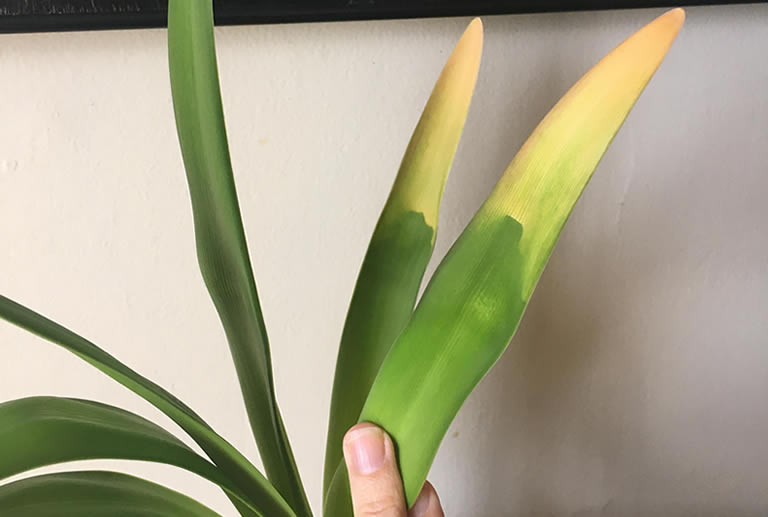Amaryllis is an easy-care succulent that is grown indoors all across America. These plants come in a variety of different colored blooms and although there are 1,600 different species of the Amaryllis, luckily, they all require identical care. So if your Amaryllis leaves are turning yellow it doesn’t matter what species of plant you have, this article will help you identify the cause and give you the solution.
So why do amaryllis leaves turn yellow?
Amaryllis leaves turn yellow when the bulb enters dormancy. This is the most likely cause of yellow leaf tips.
Faded leaf color, that reassembles a yellowing effect, can indicate one of 6 potential problems. The most likely cause being an overworked amaryllis bulb.
Let’s delve deeper into the causes and cures for yellowing amaryllis leaves.
Table of Contents
The 6 potential reasons why you’re amaryllis leaves are turning yellow
Amaryllis is an easy-care plant that requires very little attention other than regular watering and ensuring it is positioned somewhere that gets plenty of sunlight.
Because it is an easy-care indoor plant many Amaryllis owners think they have failed to care for the plant properly when they see the leaves on the plant start to turn yellow.
The most common yellowing effect on an amaryllis leaf usually starts at the tip of the leaf and slowly works its way back towards the base of the plant over a period of time.
The leaf will also collapse under its own weight during this process.
This slow yellowing effect from the tip to the base of the leaf makes for a disturbing sight for many
Amaryllis plant owners as they desperately take different actions in an attempt to save their beloved plant (which is the wrong thing to do).
The 6 causes for yellowing leaves on an amaryllis plant are:
- Bulb dormancy
- Excessive prolonged periods of strong direct sun
- Lack of the correct type of sunlight
- Lack of soil nutrients
- Over-fertilization
- An overworked bulb/a prolonged growth cycle
Let’s look at these causes of yellowing leaves more closely.
1. Bulb dormancy – a part of the plant’s natural growth cycle
Amaryllis leaves will start to turn yellow, usually at the tip first, when the plant is entering a state of dormancy.
This is part of the natural cycle of the plant.
The yellowing on amaryllis leaves, in conjunction with a drooping of the leaves, makes it look as though the plant is slowly dying.
This is especially true when the yellowing effect slowly creeps from the tip of the leaf to base.
The most likely cause for amaryllis leaves turning yellow is simply that the bulb is entering a stage of dormancy.
You can rest easy however, as the yellowing of the leaves is merely a natural byproduct of the plant entering a state of dormancy.
During dormancy the bulb sheds its foliage in order to gather and store resources for the next growth phase.
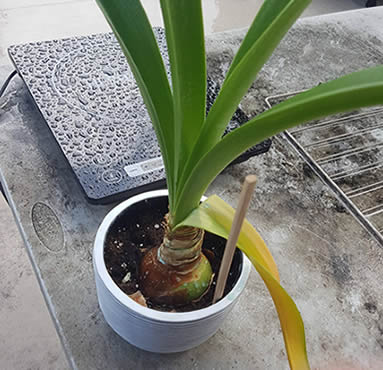
Unfortunately though, with the lack of information available online in connection with yellowing Amaryllis leaves many plant owners panic and start taking pruning shears to the leaves.
This is not a good idea for the reasons I will cover later.
Overall fading of the leaf color resembles a yellowing effect which has more serious cause
You will find in some forums that plant owners are concerned about the leaf color of the amaryllis changing shade over time.
In some forum posts amaryllis owners get confused between a yellowing of the leaves (indicating the bulb is entering a state of dormancy) and a fading of leaf color over time.
In one such forum the user sangel posted the following image of their amaryllis plant leaves.
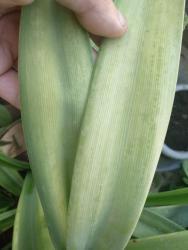
The forum user was concerned by the color of the leaves – which they should be, as anything but a deep green color is an indication that something may be wrong with the plant.
This color-fading effect on an amaryllis plant can have several different possible causes each of which I will cover now.
Having said that, there is one cause for the yellow color-fading effect in amaryllis leaves which is by far the most likely to be the culprit – an overworked bulb.
I will cover that one last as it is important to know all the other potential causes as well in case one of those applies to your specific plant.
2. Excessive prolonged periods of strong direct sun
Excessive sun on any plant can lead to a fading of leaf color.
However, as amaryllis is a succulent it loves plenty of sunlight and so excessive sun is unlikely to be the culprit for a yellowing of the leaves.
I have yet to see an amaryllis with faded yellowing leaves that was a result of too much sunlight.
Be aware though that it is a remote possibility, especially if you get water on the leaves during the day – which can lead to leaf scorching.
If you find that the leaves are also drooping as well as fading in color to a yellowish hue then the opposite of too much sunlight may be the case.
3. Lack of the correct type of sunlight
Insufficient sunlight can lead to yellowish leaves in amaryllis as the lack of light means the plant is not getting enough resources for effective photosynthesis where water and carbon dioxide are converted to glucose.
This glucose is used by the plant for energy and to make substances like cellulose and starch.
Thus it is difficult for the plant to maintain its natural deep green hue and can even negatively affect the constitution of the leaves.
If the leaves are also drooping and the plant is leaning or falling over then you will want to read this article as well so you can take immediate action to remedy the situation.
4. Lack of nutrients in the soil
Lack of soil nutrients, and using the wrong soil type, can lead to an amaryllis plant with pale green or color-faded yellowish leaves.
Amaryllis needs plenty of food and thrives in a nutrient rich potting soil.
Miracle-gro potting mix or a similar type of nutrient-rich soil is the best growth medium for this type of succulent.
If the soil the plant is growing in is nutrient-deficient the plant will display color-faded drooping foliage and lack luster blooms or no blooms at all.
However, sometimes too much food is just as bad.
5. Over-fertilization
Fertilizing your amaryllis can be tricky business for many plant owners.
Although a succulent, amaryllis like aloe vera, is more water-dependent than desert bloomers such as haworthia, and requires a more nutrient-rich environment to grow well.
This means that occasionally you will need to fertilize your plant.
Over fertilization though can lead to tip burn and a yellowing of the leaf.
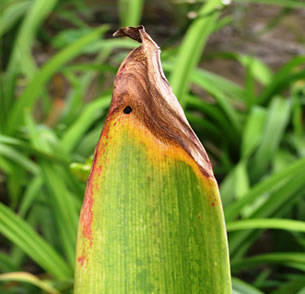
One way to deal with the problem of over-fertilization is to wash the soil while ensuring that the pot the plant is in has plenty of drainage.
This is not advised if you are dealing with an outdoor amaryllis that has been planted directly in a garden as it could easily get water-logged.
You may need to remove the bulb and gently wash its roots before washing the garden soil. Make sure the water has drained away sufficiently before replanting the bulb.
Although it is possible to grow amaryllis in water (see our watering guide) it does not like sitting in water-logged soil as this can lead to root rot or fungal infections.
With an indoor or outdoor potted amaryllis you can either wash the soil or repot the plant in new soil after having gently washed the roots of the bulb.
6. Overworked bulb due to a prolonged growth cycle
Preventing amaryllis from entering a state of dormancy, which usually lasts between 2 – 3 months, will lead to a sickly plant.
When amaryllis bulbs are prevented from from resting, and forced to remain in the growth or blooming stage, the plant will react badly.
Preventing an amaryllis bulb from entering dormancy is the most likely cause for color-faded yellowish leaves.
In image 2 shown below, provided by the same forum user, the image clearly shows the faded pale/yellowish leaves on the amaryllis.
But as you can also see, one of the leaves is displaying a strong yellow color around the tip and is beginning to droop.
This is an indication that this amaryllis is entering a state of dormancy.
So, as well as having some other problem that is associated with its faded leaf color this amaryllis plant is about to go into the stage of dormancy.
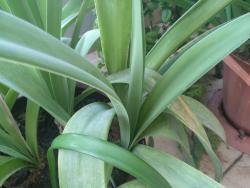
So, you may be wondering what should you do in a situation like this. The plant has obvious problems that may require attention, such as lack of nutrients in the soil.
In such case should the bulb be left alone to go dormant for awhile or given treatment?
As this plant is displaying poor leaf color it is all too easy to jump into action and add fertilizer to the soil in an attempt to help improve the foliage.
However, in this particular situation this would be a mistake and would lead to even more problems.
It is my educated guess that taking action to improve the foliage of the plant, or trying to force it to rebloom, is precisely what the owner of the above pictured amaryllis has been doing.
You see, by adding fertilizer to the soil just as the amaryllis is entering a stage of dormancy this plant has been forced to enter a new growth stage thus preventing the bulb from resting.
Doing this actually leads to faded leaf color with each new growth instead of improving it.
It also leads to poor blooms, no blooms or faded flower color.
This plant should be allowed to rest. And only when it begins to grow again should action be taken to improve the nutrient content of the soil (though it may be perfectly fine).
I would allow the plant to rest and complete its dormancy phase, which may last longer than usual.
Only then would I repot it using fresh potting soil after it has entered its next growth stage. 9 times out of 10 this will fix this plant’s problems.
When you see signs of yellowing should you cut the leaves off your Amaryllis?
So when you see yellow leaves on your amaryllis, or other forms of leaf damage, should you cut the leaves off?
You should never cut the leaves off amaryllis.
Allow them to die naturally as cutting them off will likely force the plant to enter another growth cycle and prevent the bulb from resting.
Amaryllis bulbs require 2 – 3 months of dormancy to ensure healthy and vibrant future growth.
Ok, so you shouldn’t cut the leaves but is there anything else you should do when you see the leaves of your amaryllis turning yellow?
What to do when amaryllis leaves turn yellow
So what should you do when amaryllis leaves start to turn yellow?
In most cases, when amaryllis leaves turn yellow you should do nothing.
The plant is entering a stage of dormancy that lasts a few months.
Unlike other plants amaryllis can still be left in areas with plenty of sunlight during dormancy as the bulb does not need darkness to rest.
You can leave the plant where it is and just continue your regular care routine but avoiding using fertilizer.
As you can see amaryllis really is an easy-care indoor plant.
If you ensure the care routine is consistent and adequate for this type of water-dependent succulent you will continue to see healthy foliage and vibrant blooms on your amaryllis for several decades to come.

